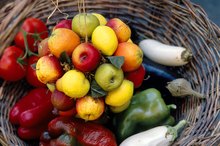Reheating Cooked Vegetables & Nitrates
Nitrates may be well-known for their presence in processed meats, but you probably get more nitrates from vegetables than from eating bacon or bologna. You may lower the amount of nitrates when you cook vegetables, but it depends on how you cook them. Reheating vegetables, however, has little effect on nitrate content.
Nitrates
A mixture of nitrogen and oxygen, nitrate exists in minerals, soil, ground water and the atmosphere. Nitrate is not harmful, but the body converts nitrate to nitrite, and nitrite can cause health problems. The nitrogen in nitrate helps plants grow, so they normally absorb it from the soil, and it’s a common ingredient in fertilizers. This means that vegetables naturally contain nitrate. The typical American diet provides about 75 to 100 milligrams per day of nitrates, according to the New Hampshire Department of Environmental Services. The World Health Organization determined that the acceptable daily intake is 222 milligrams for a 130-pound adult.
- A mixture of nitrogen and oxygen, nitrate exists in minerals, soil, ground water and the atmosphere.
- Nitrate is not harmful, but the body converts nitrate to nitrite, and nitrite can cause health problems.
Nitrates in Vegetables
Foods Containing High Levels of Nitrates
Learn More
If you eat a well-balanced diet, chances are good that you get more nitrates from vegetables than any other source. If you’re a vegetarian, you may consume up to 250 milligrams of nitrates a day, according to the New Hampshire Department of Environmental Services. While all vegetables have some nitrate, spinach, celery, beets, radishes, lettuce, collard greens and cabbages contain the highest concentrations. The amount of nitrate in any particular vegetable depends on soil conditions, amount of fertilizer used and the maturity of the plant. When more fertilizer is used than the vegetable crop needs, the plants accumulate more nitrate. This is true whether the crops are grown conventionally using synthetic fertilizer or organically using organic manure as a fertilizer. Vegetables grown without any type of fertilizer will contain nitrate picked up from the soil, but less overall.
- If you eat a well-balanced diet, chances are good that you get more nitrates from vegetables than any other source.
- Vegetables grown without any type of fertilizer will contain nitrate picked up from the soil, but less overall.
Effect of Cooking
The method used to cook vegetables affects the amount of nitrate they retain, but the effect of reheating is minimal, since it doesn't take long to warm vegetables. Nitrates leach out of vegetables when they're boiled; the longer they're boiled, the more nitrates you'll lose. However, when you boil vegetables, you also lose healthy nutrients your body needs. Cooking methods such as steaming, roasting and stir-frying ensure that vegetables retain nutrients, including nitrates. For most people, that shouldn't be an excessive amount of nitrates since the average diet includes less than half of the maximum intake recommended for a 130-pound adult. If you have any concerns about nitrate intake, whether you may consume too much or its effect on your health, talk to your health-care provider.
- The method used to cook vegetables affects the amount of nitrate they retain, but the effect of reheating is minimal, since it doesn't take long to warm vegetables.
Considerations
Do Vegetables Lose Their Nutrients When Baked?
Learn More
Nitrate relaxes blood vessels, so medications containing nitrate are used to relieve chest pain. Nitrate may also help lower blood pressure. However, bacteria in the mouth and gut turn nitrate into nitrite, and nitrite interacts with other substances in the body to create cancer-causing compounds. Nitrite also interferes with hemoglobin’s ability to carry life-sustaining oxygen. This isn’t a problem for adults, but the immature digestive system of infants makes them more susceptible to nitrite. If you make your own baby food, avoid using the high-nitrate vegetables or limit the serving size to 1 to 2 tablespoons per feeding, suggests the University of Maine Cooperative Extension.
- Nitrate relaxes blood vessels, so medications containing nitrate are used to relieve chest pain.
Related Articles
References
- The American Journal of Clinical Nutrition: Nitrate in Foods – Harmful or Healthy?
- University of Maine Cooperative Extension Publications: Making Your Own Baby Food
- Nutrition and Health: Effect of Cooking on Nitrate Levels in Vegetables
- Agency for Toxic Substances and Disease Registry. ATSDR Case Studies in Environmental Medicine Nitrate/Nitrite Toxicity. 2013.
- Agency for Toxic Substances and Disease Registry. Nitrates/nitrites poisoning patient education care instruction sheet.
- Agency for Toxic Substances and Disease Registry. Nitrate/Nitrite Toxicity What Are U.S. Standards and Regulations for Nitrates and Nitrites Exposure? Updated August 9, 2016.
- Alshahrani SM, Fraser GE, Sabaté J, et al. Red and Processed Meat and Mortality in a Low Meat Intake Population. Nutrients. 2019;11(3):622. doi:10.3390/nu11030622
- Zhang Y, Zhao G, et al. Nitrite accumulation during storage of tomato fruit as prevented by hydrogen gas. International Journal of Food Properties. 2019;22(1):1425-1438. doi:10.1080/10942912.2019.1651737
- Jackson JK, Patterson AJ, Macdonald-Wicks LK, et al. Dietary Nitrate and Diet Quality: An Examination of Changing Dietary Intakes within a Representative Sample of Australian Women. Nutrients. 2018;10(8):1005. doi:10.3390/nu10081005
- Machha A, Schechter AN. Inorganic Nitrate: A Major Player in the Cardiovascular Health Benefits of Vegetables? Nutr Rev. 2012;70(6):367-372. doi:10.1111/j.1753-4887.2012.00477.x
- Agency for Toxic Substances and Disease Registry. Toxic Substances Portal — Nitrates and Nitrites. Updated November 23, 2015.
- Lidder S, Webb AJ. Vascular Effects of Dietary Nitrate (as Found in Green Leafy Vegetables and Beetroot) via the Nitrate-Nitrite-Nitric Oxide Pathway. Br J Clin Pharmacol. 2013;75(3):677-696. doi:10.1111/j.1365-2125.2012.04420.x
Writer Bio
Sandi Busch received a Bachelor of Arts in psychology, then pursued training in nursing and nutrition. She taught families to plan and prepare special diets, worked as a therapeutic support specialist, and now writes about her favorite topics – nutrition, food, families and parenting – for hospitals and trade magazines.









